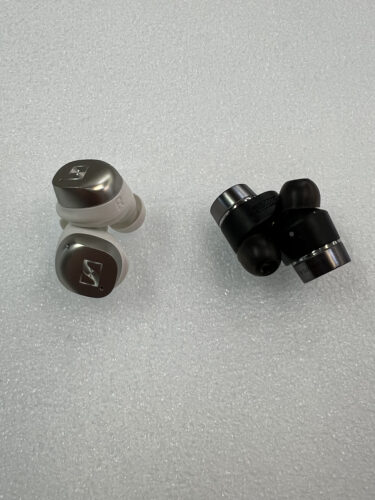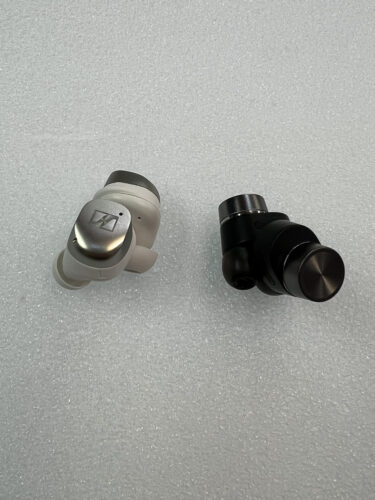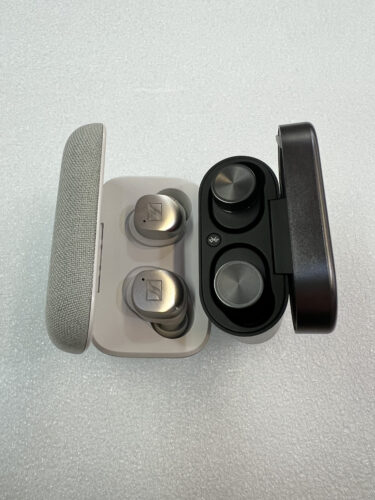About half of the audiophiles I know will still carry around a pair of TWS earbuds for their day to day listening. As much as purists swear by their wired systems, I’ve encountered a lot of people who are tired of carrying a DAC, IEMs, and spare cables. With advances made to bluetooth fidelity since it’s inception, more and more people are switching to TWS earbuds simply because of their ease of use. Nevetheless, with so many options, it’s difficult to pick a model that will come close to the volumes wired listening devices produce. Bowers & Wilkins and Sennheiser are two reputable brands that produce some super high quality products. Let’s see how the Sennheiser Momentum True Wireless 4 and B&W Pi7 S2 stack up against each other in the comparison review.
What’s in the Box?
| PI7 S2 earbuds
Charging case Type C charging cable 3.5mm to USB Type C cable S/M/L ear tips |
Momentum True Wireless 4 Charging Case Extra Wing fins S/M/L Ear Tips USB Type C Charging Cable User Guide |
Battery – Sennheiser Momentum True Wireless 4 Vs. B&W Pi7 S2 Comparison Review
I wanted to get the simplest stats out of the way first. Simply put, the Momentum’s battery life and charging case are by far and away superior to the B&W. At 30 hours of playtime with the case and 7.5 by themselves, the Momentum 4 has some of the best battery life in this quality range. Compare this to 5 hours for a single charge and 16 with the case for the Pi7 S2. When you couple this with the fact that the Sennheisers have a quick charge option (1 hour in 8 minutes of charge), it’s clear these are the best battery option.
The 9.2mm dynamic driver and balanced armature in the Pi7 sound fantastic for a bluetooth earbud. The sacrifice with this is that they demand a lot of power for a wireless device. This means that although you’re getting great audio quality, you’re going to have to sacrifice battery life if you get these.
Bluetooth
The most important improvement Sennheiser made between the Momentum 3 and 4 is the inclusion of Bluetooth 5.4. Auracast Bluetooth allows users to share their signal wirelessly. Both of these earbuds include aptX lossless CODECs for android users.
The B&W Pi7 S2 still supports Bluetooth 5.0 and a plethora of aptX CODECs. Regardless of this, the earbuds were able to pair almost instantly. I didn’t experience any signal loss in with them while listening. Although they function without a problem, I wanted a more updated Bluetooth from the second iteration of the Pi7. At $399, I was expecting newer Bluetooth from Bowers & Wilkins. For this reason, I have to go with the Momentum 4 in this field.
Look and Feel
I can’t tell you that I have strong feeling about either one of these earbuds appearances. Although I think they both look great, the main difference between these are the hard edges and circles on the Pi7 S2 and the smoother look of the Momentum 4. The Sennheiser option fits a little better in my ear, but this is relatively subjective considering all of our unique ear shapes. I get a good seal from both eartips. The Pi7 S2 feels marginally heavier, however they both weighed in at 6 grams per earbud on my scale. The main selling point of the B&W is how vibrant the colors look. The understated visuals of Sennheiser gets beat out by the Pi7 S2, but with styling so similar, it really isn’t too far behind.
Design and Functionality – Sennheiser Momentum True Wireless 4 Vs. B&W Pi7 S2 Comparison Review
There’s a lot to be excited about in both of these headphones. Sennheiser’s Momentum 4 retains the same True Response dynamic driver from older models. What has changed are the microphones that enhance Bluetooth and increase call fidelity. The Sennheiser app offers the option of 20 different unique EQ settings for different locations. The EQ itself works relatively well, and I didn’t experience distortion from boosting certain frequencies. You’ll also be able to customize touch controls in the app. Some say the ANC isn’t as good as the Sony WF-1000XM5, but i actually prefer how subtle the Momentum’s ANC feels.
The Pi7 S2 sports a dynamic driver with balanced armatures. These sound fantastic, bringing a lot of focus and clarity to the sound. The ANC isn’t bad, but it isn’t something to write home about either. I wasn’t able to hear many things peeking out from outside of the listening environment, but it’s not as clear as the Sennheisers. Super fast and responsive touch controls make these extra useful for listeners on-the-go. The lack of EQ options puts them far behind the Momentum 4 in terms of customizability. However, many listeners who don’t bother with EQ settings will not notice this.
Soundstage
Some Bluetooth headphones have a characteristic closeness and shortness in their soundstage. For a longtime this has been a problem that high-end companies have tried to work against. Recently, staging has improved significantly in a lot of flagship models, and both of these are no exception.
The best impression I have of the Pi7 S2 comes in its wide and holographic soundstage. For a TWS earbud, these sound rich, wide, and vertical. Textures pop through relatively clearly and I’m getting a good depiction of the stereo image. Sounds can be localized and close but also wide and inundating. I wouldn’t say that these feel totally natural, there is some added reverb for depth in them. It isn’t very noticeable unless you’re paying close attention. “Wormtamer” By Grinderman swirled away from my ears impressively. There’s a satisfying verticality to the sound, but it’s much wider than it is holographic.
The Momentum 4 offers a similar width that’s truly impressive for a TWS earbud. “Allison” by Slowdive was decadent and wet sounding. The hazy “soft-focus” effect on the guitars in this track washed over my ears as if I was listening to waves crashing along a shoreline. There’s slightly less width than the Pi7, but it’s very marginal. The verticality is similar from these, but what is different is how localized the stereo image was. I genuinely think that if you got the EQ flat enough, you’d be able to pan a mix with these earbuds.
Although I prefer the soundstage of the Sennheisers, I have to admit that the Pi7 S2 has the widest stage from any TWS earbud in the field. I say this because I like how localized the image is, and I’m not a fan of added reverb on listening devices. Despite this, B&W has mixed the reverb so it isn’t egregious. For this reason, I have to choose the Pi7 S2 because of how impressive it’s staging is.
Listening Impressions – Sennheiser Momentum True Wireless 4 Vs. B&W Pi7 S2 Comparison Review
Lows
The focus of the B&W Pi7 S2 is it’s low end. There’s a ubiquitous boost to the bass frequency spectrum. The most spectacular part of the sound signature has got to be it’s pumping sub-bass. There’s got to be elves powering these drivers, because I’ve never heard so much ‘boom’ from a wireless device except for maybe the Focal Bathys. In this light, the sub-bass feels magical in the way that it can thump. It can be overpoweringly warm when songs are mixed with way too much bass, but generally they’re pretty fantastic in elevating the bass volume. Contrastingly, live performances which characteristically have less bass are really enhanced by listening to these.
The Momentum 4s aren’t as bass heavy as the Pi7 S2, but they can come close by boosting low frequencies in the app. There’s a flatter ‘v-shape’ to the frequency response which slopes down throughout the low end. There’s an adequate amount of sub-bass, but it will not thud in the same way that the Pi7 can. Considering you cannot EQ the B&W, this gives the Momentum it’s own advantages. This bass signature in my opinion is way more versatile, and with the app customization, you’re able to shift the bass response song to song. If you want a bass heavy earbud, you can come relatively close. Bassheads will prefer the Pi7 S2 over the Sennheisers. Fans of a flatter response will enjoy the Momentum 4 much more.
Mids
There’s enough mid sharpness in the Pi7 S2 to keep details and focus in the sound signature. At the same time, the huge bass punch does extend into the lower mid-range. Although songs have a great warmth, there’s a little bit of muddiness in certain sounds. I wouldn’t say that all elements are effected negatively by this low mid bump. Shimmery voices on tracks like “Shining Star” by Smerz are given just enough roundness to enhance a bright and loud mix. At the same time, I can’t call the mid presentation too inspiring. It seems as if it was tuned to give enough detail without being drowned out by bass sounds.
Similarly, the mids on the Momentum 4 aren’t the focus of the sound signature to me. The ‘v-shaped’ frequency response slopes down more subtly than it does on Pi7, meaning you get a much flatter mid response from these. A slight boost at 1k made them sing a lot more in this range. Voices, guitars, and synths all come alive from only a 2dB increase. That being said, I did want a little more from this range out of the box. It’s not lacking focus, but music sounds much cleaner with this slight adjustment.
Highs
Treble on the Sennheiser Momentum 4 is definitely pleasant. It isn’t too bright, but there’s enough presence and brilliance to give sounds a great shape. Cymbals are able to ring and chime well, but these don’t really feel sharp. Voices and cymbals also don’t have sibilance issues. There’s enough airiness in the timbre to make listeners feel like they’re getting an even display of the mix. The treble is a little flatter than the bass here, but louder than the mids. I gave the EQ a 2dB attenuation at 4KhZ. That brought the earbuds to the next level for me. Jazz took on a totally new character, as the ‘chicks’ of a rolling hi-hat became that much more apparent.
I wanted more from the original Pi7 in terms of treble. B&W has definitely done this with the S2. Brightening up this bass-boosted earbud has given sounds a little more air, but really hasn’t taken away from the signature response of the headphone. Listeners can expect a subdued yet noticeable presence. If you like very bright sounding earbuds, I wouldn’t say that these are for you. On the other hand, there’s enough attack to give a dark sound more glassiness. Higher frequencies can at times be overtaken by the thudding bass, but this happens much less often than it did on the first version.
Summary
Fans of different sound signatures will absolutely have strong feelings when choosing between these 2 TWS earbuds. The B&W Pi7 S2 has the strongest bass out of any TWS on the market right now, a great soundstage, and a noticeable look. The Momentum 4 on the other hand has a superior battery life, Bluetooth support, and a nicer presentation of the mids and highs (in my opinion). Although both of them have some great features, I have to chose the Sennheiser Momentum 4, for it’s ‘v-shape’ response and EQ customization. If you’re a basshead who doesn’t want to fuss around with attenuation, the Pi7 S2 will undoubtedly be a better option for you.
Get the B&W Pi7 S2 and Sennheiser Momentum 4 at Audio 46.
MAJORHIFI may receive commissions from retail offers.











